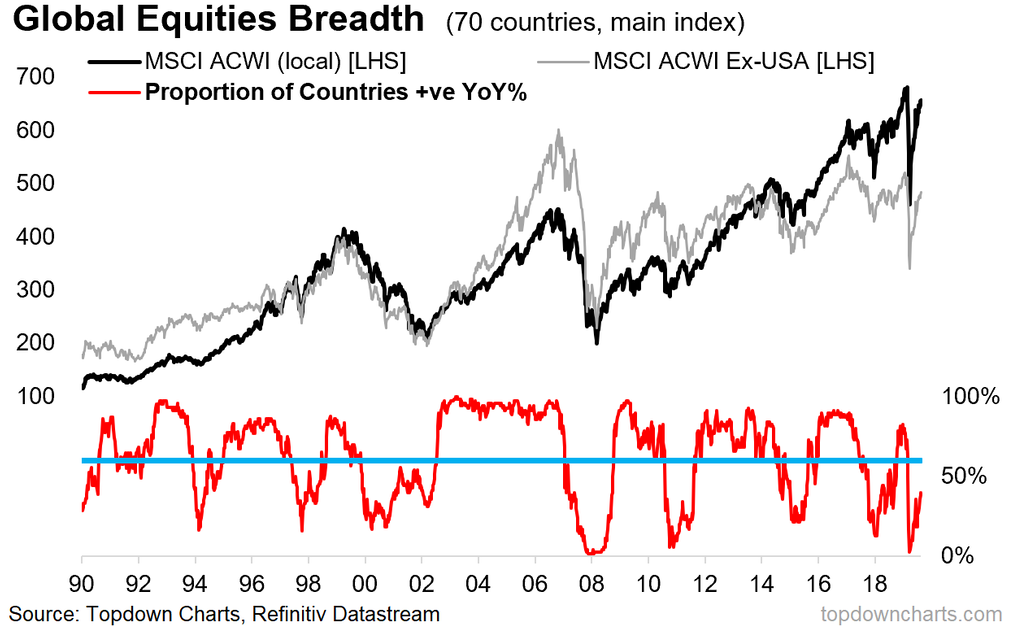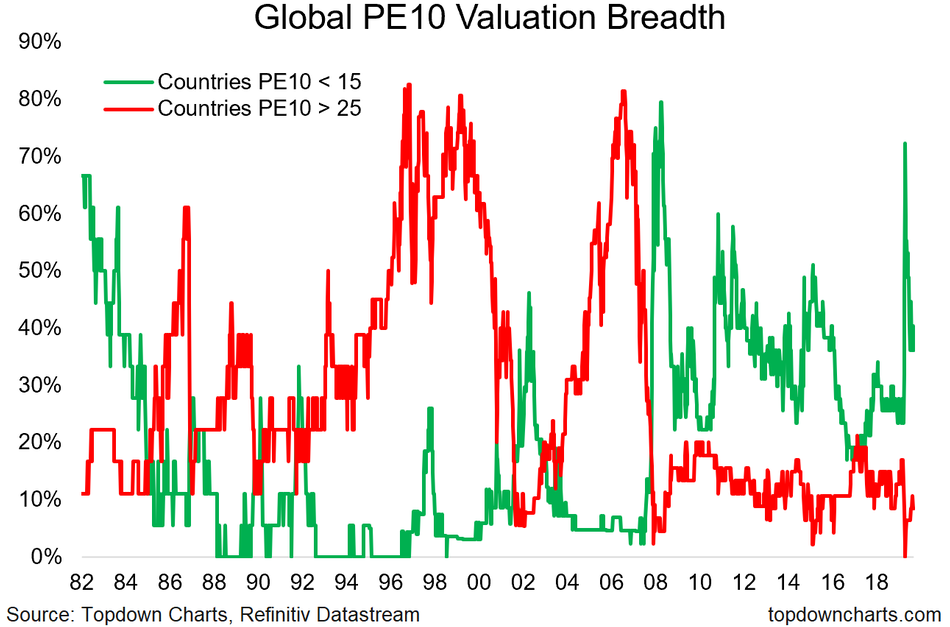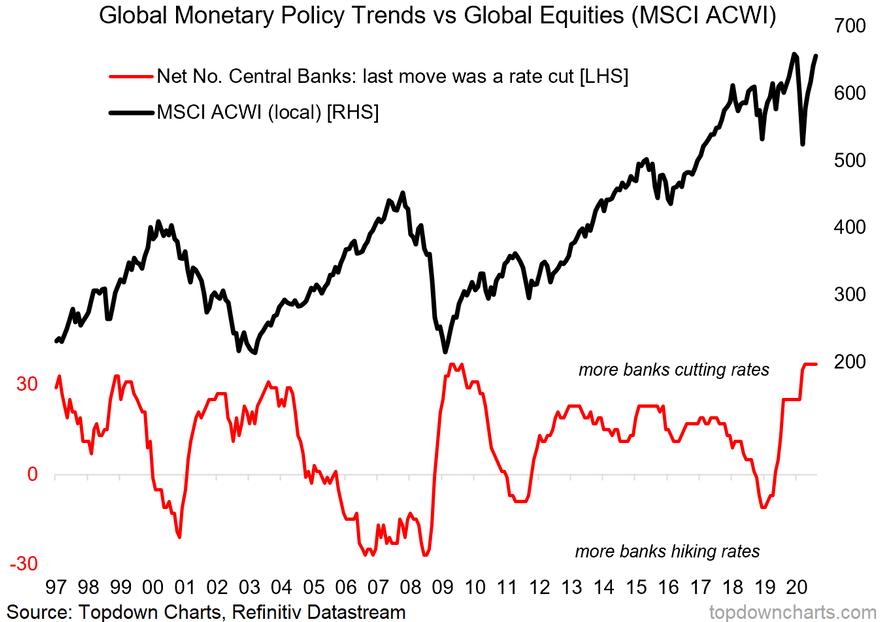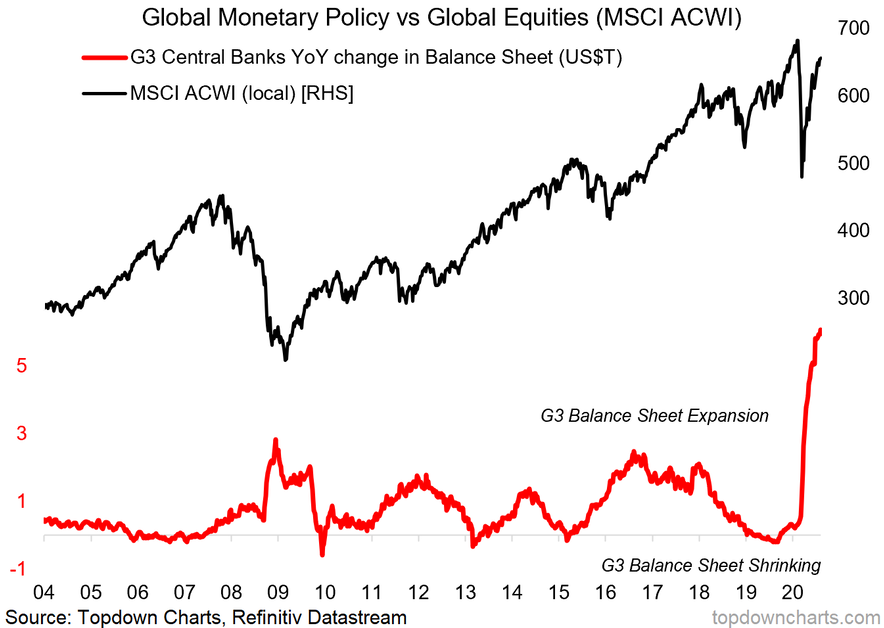UPDATED (13-August-2020): Well. What a difference a few months can make...
I thought it might be helpful to revisit the below post (from back in March during the darkest depths of the global market crash), in terms of understanding how the risk/return outlook is evolving. In many respects we have come a long way, and certainly, sentiment has changed a lot since the extreme uncertainty, panic, and pessimism that prevailed back then. But what, if anything has changed with regards to the outlook?
1. Global Equity Market Breadth: the first chart shows the proportion of countries we track (70) whose main equity benchmark is positive on a year over year basis. After collapsing to almost zero in mid-March (bonus points to whoever can guess the 1 country that didn't go negative), this indicator has rebounded to 40% at the time of writing. This pattern of collapse and rebound is a textbook medium-term bullish signal, which has worked more often than not. But we remain below a majority, and until that blue line is cleared, there is a real possibility of another leg down: with 2001/02 the key cautionary instance of a partial recovery in market breadth.

2. Valuation Breadth: staying with breadth indicators, but this time looking at the proportion of countries showing up as "cheap" (green line) vs "expensive" on a PE10 basis. Back in March, with the big valuation reset just over 70% of countries moved to cheap valuations, and for a brief moment zero were trading on expensive valuations. That was one of those rare moments where, when valuation reaches extremes they tend to speak for themselves. At the time of the original article below, my comments were greeted with substantial skepticism—but in many ways, that only serves to reinforce the usefulness of valuation as a medium-term market timing signal: when equities are cheap, most people wont want to buy, so those who are able to keep a level head and stay focused on the data and the charts will have an edge. And the experience of this year has only served to galvanize the value in my mind of such indicators and indeed my overall process in general.

3. Global Equity Valuations: looking specifically at the PE10 valuation ratio (and I discuss why we should look at the PE10 vs other indicators in this article) for the major chunks of global equities, we can see both how valuations have developed through the ups and downs of 2020, but also a couple of very important directives for the months and years to come. At present, US equity valuations from a variety of angles are trading at historically expensive levels; particularly relative to global ex-US. This firmly tilts the odds in favor of global ex-US equities (i.e. the rest of the world) vs US over the medium-longer term. Indeed, if you look at developed markets and emerging markets, they both look reasonable, if not still somewhat cheap vs history.

4. Global Monetary Policy Pulse: as important as valuations and technical indicators like market breadth are (as you can probably gather from my notes here), they tend to take on most importance at extremes, and we have now moved away from extremes. Also, aside from those factors, it was the swift and decisive global wave of policy easing that helped raise my bullish conviction back in March. But we are no longer in March. Indeed, as I noted in the July Market Cycle Guidebook, "as we enter the second half of the year, we also enter a sort of second phase of the market cycle". Supporting that transition is continued and historic (magnitude and coordination) monetary policy easing. This easing of policy has 3 key effects: confidence and signaling, liquidity, and economic stimulus (i.e. the promise of a future rebound in the economy/earnings).

5. Global Central Bank Balance Sheet Expansion: indeed, whether you look at policy rates, asset purchases, or fiscal policy... the global policy response has been in many respects on a whole different scale to what we've seen in recent history. In fairness, the challenges and uncertainty of the current environment are also quite different to anything seen in recent history... and it would be wrong of me not to acknowledge that some parts of the traditional policy transmission channels are presently impaired (to say the least). But sooner or later some semblance of normalcy will return, and the world will find a global economy up to its eyeballs in stimulus. It may still be a hard idea for some to grasp given the very real uncertainty and challenges we still face right now, but I can envision a potential multi-year economic boom on the other side of this that will equally outshine anything seen in recent history. Hence, until I see the key charts and indicators which I track move clearly into the bearish/warning phase, I struggle to justify anything but a firmly bullish medium-term stance. Naturally that doesn't preclude a few episodes of volatility along the way, and perhaps some substantial rotation within asset classes, but I guess the punchline is to err on the side of optimism and hope for a brighter future yet to come.

Final Thoughts and Bottom Line
Bottom line: valuations and market breadth have moved away from the extremes of March, much in line with the way markets usually behave early in the cycle (I almost think of this as a condensed market cycle). As we enter phase 2 of the market cycle, attention shifts towards the monetary/stimulus tailwinds, and confirming indicators. Given the historic global stimulus efforts, and the lack of bearish/warning indicators, I remain bullish global equities; particularly skewed to global ex-US from a relative value standpoint.
As noted, while it's hard to see right now and there are plenty of uncertainties and risks, it's entirely possible that we go from bust to boom as a simply historic global stimulus effort has kicked off and continues to ramp up (historic in terms of magnitude, coordination across countries, coordination across fiscal and monetary policy). One can only imagine what the other side of the pandemic will look like with such a forceful tailwind, and no doubt a substantial relief wave lifting confidence, and potentially a new wave of innovation and adaptation stemming from the challenges of these strange times.
Aside from that, to leave you again with some parting comments: keep on keeping on, tune down the noise and the bullsh*t, tune up the optimism and focus on progress where possible. These kinds of times reveal a lot about the character of individuals, and character of nations, and certainly give good cause for reflection. The question I keep asking myself, is "how do you want to come out of this?" ... to me that's both a question of what do you want to be remembered for in how you responded to this historic moment (what would you tell your grand kids? ...would you be proud of how you acted, how you treated others, how you treated yourself?) and how do you want to position yourself coming out of this if we do end up with a resurgent economy?
A bit of a philosophical tangent I know, but that last ramble has really been a repeated thought-path for me, particularly as I see much of the world seeming to lose their patience with each other, lose their respect, and lose perspective. Just as we need to keep perspective and remain level-headed in formulating investment strategy, I think we need to also keep perspective and clarity in our day to day lives.
Thanks for your attention and for sticking with me this far!
